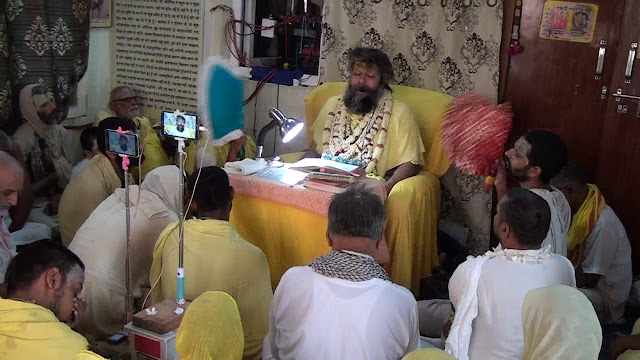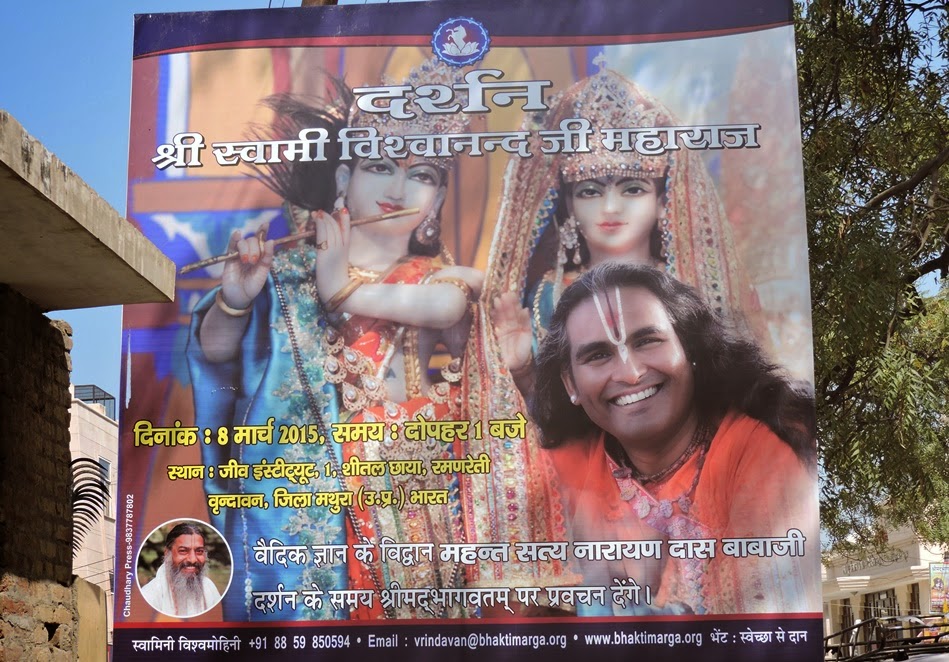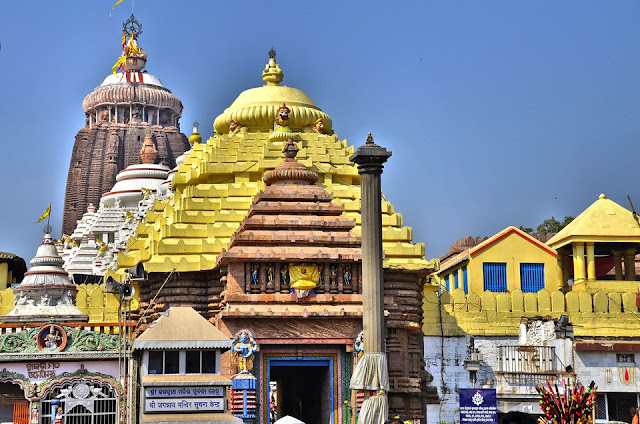Glorifying Vrindavan: Where those thirsty for Braj rasa are going these days
From Vrindavan Today: Sometimes one gets the impression that there is a certain movement afoot. Suddenly, one figure bursts into prominence and influences the general mood of the community, sets the rhythm that others follow. When the flowers bloom and their fragrance is carried by the breezes in the spring, the bees and hummingbirds who feed on the nectar automatically swarm to the colorful garden where they are arrayed.
For the past few months people have been asking me with regularity, "Have you heard Premananda Baba's Vrindavana-mahimamrita lectures? Then I started looking on the internet and saw that his enthusiasts were making his lectures available every day, so I began listening.
And today, finally, I went to Shri Hit Dham on the Parikrama Marg, in the Varaha Ghat area a bit west of the Bhaktivedanta Goshala. Vishakha Dasi accompanied me and took some photos, which you can see here: Gallery.
Madan Ter and Shri Hit Dham
Shri Hit Dham is right next to Madan Ter. It appears that the two properties, both in the hands of the Radha Vallabha Goswamis, were divided up at some time. The area now known as Madan Ter, which is the original site where Hit Harivams Mahaprabhu first stayed in Vrindavan and where Radha Vallabh was first worshiped in Vrindavan.
According to his biographers, although he was born in Braj, Harivams spent the first 31 years of his life in Devavan (Deoband) in what is currently northeastern Uttar Pradesh. He then received a dream order from Radharani who told him to go and live in Vrindavan. While on his way there, Harivamsh stopped in a place called Charthawal near Muzzafarnagar, where he again received a dream command from Radharani to marry the two daughters of a brahmin in the village, who gave him the murti of Radha Vallabha as a part of his dowry.
Harivansh arrived in Vrindavan in 1535, taking shelter in the place known as Unchi Thaur ("high ground"), which is also known as Madan Ter. The date of Karttik Shukla Trayodasi is usually given for the celebration of Radha Vallabha's Patotsava, which marks when his worship was inaugurated. This festival is celebrated annually, primarily at Madan Ter.
Though Shri Hit Dham is the property of Radha Vallabha Goswamis, the place is occupied by a few sadhus and gardeners who take care of the bagicha. There is a small temple building and a shrine to Hit Harivamsh in generally pristine surroundings, but plans for new buildings are afoot. This inevitably happens when many people start to frequent a particular site.
The mood
And there were many people, perhaps 500, who came to listen to Premananda Maharaj. The small temple building only seats thirty or forty people at most indoors, so the greater number of people sit outside in the pleasant garden surroundings, under an old but flourishing jasmine vine. Others sit on chairs under a canopy. They are of all ages and of all sampradāyas, as many women as men.
One can see the tilak of Haridasis, Nimbarkis, Gaudiyas and Ramanandis amongst others. Premanandaji's kathā is for people who are coming to take shelter of Vrindavan, who are ready to follow Prabodhananda's strong instructions to take to exclusive bhajan of Radha and Madana Mohan in the nitya-vihāra. As a matter of fact, Prabodhananda Saraswati's bhajana sthali and samādhi are just a few hundred meters away in Purana Kalidaha, right next door to Madan Mohan.
[The names Madana-mohana or Madana-gopala appear 23 times in VMA, Radha-vallabha only twice. Radha-ramana or Radhika-ramana, seven times.]
Hit Premananda Govinda Sharanji Maharaj
Those sitting outside cannot see Premananda Baba, they can only hear his voice on the microphone. You can see what he looks like clearly on YouTube, though. His hair is dishevelled and his beard untrimmed. He wears tilak of Radha Kund mitti and smears it across his forehead along with chandan and saffron.
I heard that more than twenty years ago he was an Advaita sannyasi living in Benares. Then he came to Vrindavan and took shelter of a Baba in the Radha Vallabha line, which seems eminently appropriate for one who follows in the mood of Prabodhananda. He then took up a serious study of the Radha Vallabhi vāṇī texts, especially Rādhā-rasa-sudhā-nidhi and Vṛndāvana-mahimāmṛta, along with the Braja bhasha works by Sewakji and Dhruva Das. But in his lectures, he also refers frequently to Rāma-carita-mānasa and the vāṇī-granthas of the Haridasis and the Nimbarkis, as well as the lesser known poets of the Radha-vallabhi line.
This openness to all the saints of Vrindavan is clear from the beginning of the morning sat-saṅga, when everyone sings a prayer by Bhagavant Mudita (initiated as a Gaudiya) addressed to the original greats of Braja from all sampradāyas, including those above-mentioned, as well as Chaitanya Mahaprabhu, Rupa, Sanatana, Raghunath Das and Jiva Goswamis.
Baba has only been giving pāṭha this way for the last couple of years, and most of his disciples have come to him in that time. None of his disciples lives there at Shri Hit Dham, but in other refuges nearby. They are told to devote themselves to bhajan in their own way, but to come every day for morning satsang and for another satsang in the afternoon when there are readings from the vani texts.
The pāṭha
His voice is somewhat hoarse, but clear and forceful. Indeed he thunders relentlessly in the style of one who is fully renounced and dedicated to ekānta-bhajana. His presentation is scholarly. There is no compromise in his voice.
aparataḥ puruṣārtha-catuṣṭayaṁ
bhagavato bhajanaṁ ca bhaved bahu |
dhruvam idaṁ tu vinā vṛṣabhānujā-
vanam aho na mahojjvalaṁ bhaktayaḥ ||
bhagavato bhajanaṁ ca bhaved bahu |
dhruvam idaṁ tu vinā vṛṣabhānujā-
vanam aho na mahojjvalaṁ bhaktayaḥ ||
You can attain the four goals of life elsewhere; you can even attain the worship of Bhagavan, but outside of Radha's forest of Vrindavan, there is no attaining this devotion in the brilliant mood of erotic love. (VMA 15.24)Verses like this are the ones that allow him to express the unique nature of the bhakti of Vrindavan Dham and the need to recognize the good fortune that one has to be there, among the trees and vines, the flora and fauna of the Dham, listening to the glories of Piyari and Pritam Shyam-Shyamaju, Yugal Sarkar, surrounded by other, chatak-like devotees who thirst for the nectar of their topics to the exclusion of everything else.
Most of the time Baba speaks with his eyes closed, except when he opens a book to cite some relevant passage. Today the principal verse was the following:
vṛndāraṇye sva-kara-racitāścarya-sat-puṣpa-vāṭyāṁ
nānā-puṣpādbhuta-racita-san-maṇḍape sat-pathena |
svāstīrṇāmbhoruha-mṛdu-dalenābhisāryāśu rādhāṁ
krīḍan kṛṣṇo’vatu sa bhavato juṣṭa-vartmopahāram ||
nānā-puṣpādbhuta-racita-san-maṇḍape sat-pathena |
svāstīrṇāmbhoruha-mṛdu-dalenābhisāryāśu rādhāṁ
krīḍan kṛṣṇo’vatu sa bhavato juṣṭa-vartmopahāram ||
May the playful Krishna who has with his own hand made a garden in Vrindavan full of an incredible array of flawless flowers, and therein built a pavilion with various other wonderful blossoms, and who has covered the path whereby Radha will soon come to meet him with the soft stalks of lotus flowers, protect the gift of your chosen devotional path. (VMA 15.2)
His trance-like descriptions come especially when the verse is, like this one, a meditation on the beauty of Vrindavan or the Divine Couple, or some lila. For the first half of today's class, for instance, he was absorbed in remembering Krishna's preparing the kunj for Radha's arrival, with all the uddīpanas of ujjvala-rasa, and especially emphasizing the nature of prema as taking joy in the happiness of the Beloved, tat-sukhe sukhī bhāva.
prathamaṁ mahatāṁ sevā tad-dayā-pātratā tataḥ |
śraddhātha teṣāṁ dharmeṣu tato hari-guṇa-śrutiḥ ||34||
tato raty-aṅkurotpattiḥ svarūpādhigatis tataḥ |
prema-vṛddhiḥ parānande tasyātha sphuraṇaṁ tataḥ ||35||
bhagavad-dharma-niṣṭhā’taḥ svasmiṁs tad-guṇa-śālitā |
premṇo’tha paramā kāṣṭhety uditā bhakti-bhūmikā ||36||
śraddhātha teṣāṁ dharmeṣu tato hari-guṇa-śrutiḥ ||34||
tato raty-aṅkurotpattiḥ svarūpādhigatis tataḥ |
prema-vṛddhiḥ parānande tasyātha sphuraṇaṁ tataḥ ||35||
bhagavad-dharma-niṣṭhā’taḥ svasmiṁs tad-guṇa-śālitā |
premṇo’tha paramā kāṣṭhety uditā bhakti-bhūmikā ||36||
(1) Service to great souls; (2) becoming the recipient of their grace; (3) faith in the path they teach; (4) listening to the descriptions of Krishna's qualities; (5) the first sprouting of love (rati); (6) attaining knowledge of one's own spiritual identity; (7) the increase of love, (8) its manifestation in supreme joy; (9) firm commitment to the Bhagavat Dharma; (10) the attainment of Krishna's qualities in oneself; (11) the attainment of the highest state of love.These are explained in Bhakti-rasāyana with reference to the Bhāgavatam.
It is nice to see that there is a hunger for this kind of uncompromising message of bhakti to Vrindavan. It is good that Radha Vallabh Jiu has sent someone to remind us all of Vrindavan's glories on a regular basis. Jai Sri Vrindavan Dham!!




Comments
"Glorifying Vrindavan: Where those thirsty for Braj rasa are going these days"
https://twitter.com/TheGoodDeath/status/927580836118982656